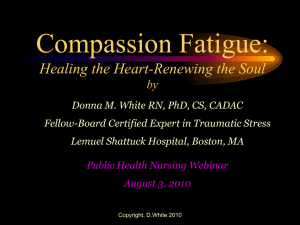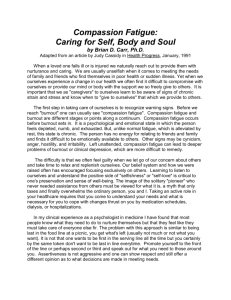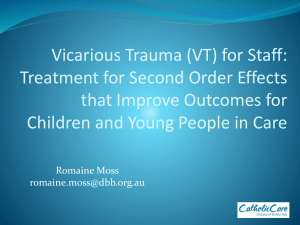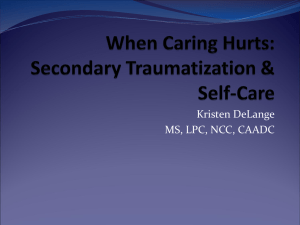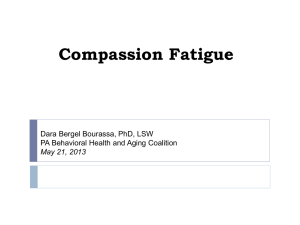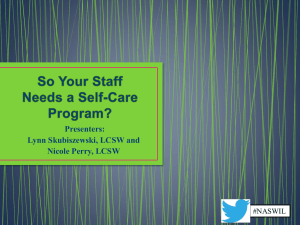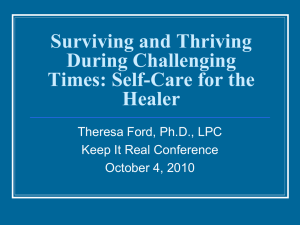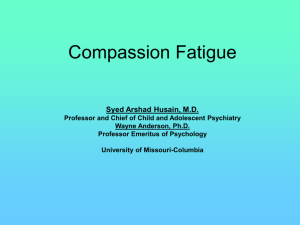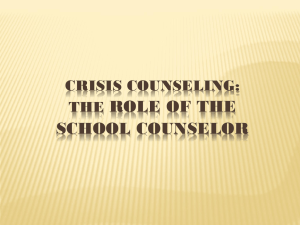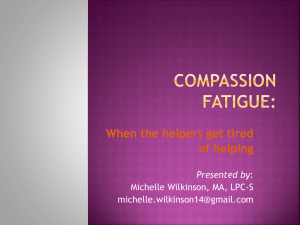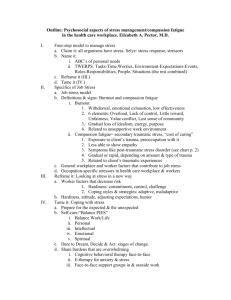Compassion Fatigue Powerpoint - Partners Ending Homelessness
advertisement
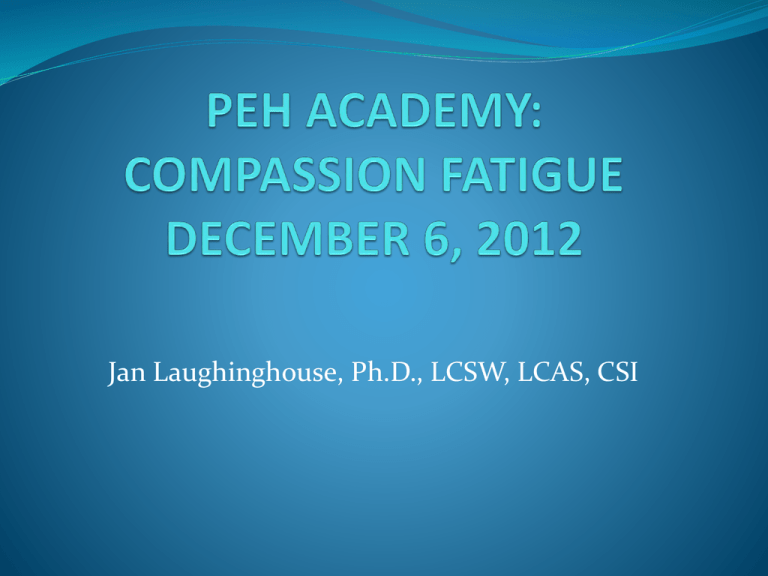
Jan Laughinghouse, Ph.D., LCSW, LCAS, CSI DISCLAIMERS Not a discussion of agency-specific issues Use of terms: therapeutic (read: healing); clinician (read: staff, or insert your title); client (read: consumer, individual, customer, resident, student or other preferred title) THE STRESSES OF HELPING Vicarious traumatization Modeling and reinforcing of workaholism Burnout or compassion fatigue Working in isolation (though among many) Underpaid and Undervalued STRESS Most commonly accepted definition (attributed to Richard Lazarus) “Stress is a condition or feeling experienced when a person perceives that demands exceed the personal and social resources the individual is able to mobilize.” (Source: mindtools.com/stress/UnderstandStress) Normal part of life Cannot be avoided Not always precipitated by negative events EFFECTS OF STRESS Stress is a health issue that can affect us as follows: Lack of energy Trouble concentrating Sleep disturbances Increased anxiety Gastrointestinal problems (diarrhea, upset stomach) Muscle aches/tension Headaches Abuse of substances Fluctuations in weight (Source: Cleveland Clinic) ASSESSING STRESS Holmes & Rahe Stress Scale (1967) Published as Social Readjustment Rating Scale (SRRS) Medical records of 5,000 patients examined Patients tallied 43 life events based on a relative score Determined positive correlation between patients’ life events and their illness Subsequent research conducted to validate the link between stress and illness Has cultural validity (tested on African American, Caucasian and Hispanic groups; also with Japanese and Malaysian groups) wikipedia.org SCORES Score of 300+: At risk of illness (90% chance) Score of 150-299: Risk of illness is moderate (reduced by 30% from the above risk) Score <150: Slight risk of illness wikipedia.org INTRAPERSONAL AND EXTERNAL FACTORS THAT COMPOUND STRESS Intrapersonal Inherited personality traits Worldview How one processes information Inability to communicate with others FACTORS (CONT’D) External Cultural background Health Religion Education Work history Living environment Socioeconomic background STRESSES UNIQUE TO WORK IN HUMAN SERVICES Emotional contagion (Miller, Stiff, & Ellis, 1988) Secondary traumatic stress (Figley, 2002) Traumatic countertransference (Herman, 1997) Compassion fatigue (Figley, 2002) Vicarious traumatization (McCann & Pearlman, 1990) Reactions that occur because “the process of empathizing with a traumatized person helps us to understand the person’s experience of being traumatized, but, in the process, we may be traumatized as well.” (Figley, 1995, p.15) Along with vicarious trauma helping professionals experience Professional crises (budget cuts, client death, violence against a a colleague in the workplace) Community crises (natural disasters) Unfinished business from previous crises Current personal life crises (illness/death of a loved one, divorce, financial crises) WORKAHOLISM (MODELED/REINFORCED) Overfunctioning is a learned behavior (Sussman, 1992). Characterizes the working style of many agencies and clinicians Other-centeredness Vicious cycle Emotional exhaustion Fatigue Detachment VS. Accomplishment Role satisfaction Pleasure of engagement (Figley, 2002; Norcross, 2000; Rupert & Kent, 2007) BURNOUT/COMPASSION FATIGUE Occupational hazard (Figley, 1995; Pulido, 2007) Results from interacting intensely with people with many severe problems over a long period with poor support Symptoms are: Physical, mental, emotional exhaustion (“I’m worn out.) Insensitivity to others (I don’t care anymore.”) Sense of futility or hopelessness (Going out there to visit will not change anything.”) Sense of isolation/invalidation (Who cares what we do anyway?”) (Murphy & Dillon, 2011) OTHER SIGNS Withdrawal from family and friends Emotional numbing Loss of interest in things enjoyed Persistent thoughts and images related to the problems of others Physical symptoms such as a compromised immune system, head and back pain, gastrointestinal disturbances, muscle tightness Sleep disturbances, including nightmares Jumpiness; pervasive feeling of uneasiness or tension Unethical activities (financial or sexual exploitation) FEELINGS OF ISOLATION Poor support Lack of funding Organizational culture Feelings of disempowerment, lack of control, and disenchantment similar to those of our clients UNDERVALUED/UNDERPAID Historically undervalued, underpaid, and undersupported Other professions enjoy Greater pay Greater benefits Greater respect Does it matter that we Have education? Have years of experience? Provide an important community service? Are willing to work with populations marginalized by other professions? (Murphy & Dillon, 2011) PERSONAL ASSESSMENT Burnout Assessment & Discussion STRATEGIES OF SELF-CARE Identify what sustains you and what does not Work settings Colleagues Types of support (Sweitzer & King 2009) Someone who listens without advising Sound advise when it’s needed Praise from “fans” Friends to relax and play with “Chicken soup people” who comfort People who challenge you to go further or deeper SUPPORT (CONT’D) The companionship of “buddies” with whom you can say or do anything without fear Affirmation and validation from people who’ve had similar feelings or experiences (p. 27) SELF-EMPATHY (Jordan, 1991) Value yourself Think about your needs differently Connect with others to experience Rest and renewal Support and validation Self-actualization Effectiveness at home and at work (Murphy & Dillon, 2011) TAKING PERSONAL TIME AND SPACE Relax and nurture self Self care should be routine and not accidental Limit exposure Take some time away (personal/vacation time) GOOD HEALTH PRACTICES Regular exercise Healthy diet Minimizing use of substances Caffeine Nicotine Alcohol/other drugs Work breaks POWER OF HUMOR Cartoons Sayings Reflect on human folly Nothing that hurts or offends THE VARIOUS MENTAL DISORDERS OF WINNIE THE POOH CHARACTERS (thejailbreak.com) CONNECTING WITH LIKEMINDED OTHERS Family/friends Hobbies Cultural rituals Spiritual retreats Provide opportunities for creative expression, feedback, and friendship Connections not made around discussions of workplace stress SPIRITUAL RESOURCES Meditation Mindfulness Prayer 96 fifteen-minute blocks in 24-hour period Use 10-15 to pray/meditate Help alleviate sleep problems due to worry DO CREATIVE THINGS THAT PLEASE YOU (Create meaningful experiences) Gardening Working out Sports Playing an instrument Quilting or knitting Listening to music Writing poetry Reading Cooking TALK WITH OTHER STAFF Angry/negative ventilation in a peer group Exercise balance Too much negativity can lead to cynicism and hopelessness Focus on examples of strength and resiliency (Dr. Beverly Smallwood) Incorporate the “”hardiness factors Commitment Control Challenge (Dr. James Pennebaker) HOW TO COPE: RECAP “Burnout is a state of emotional, mental, and physical exhaustion caused by excessive and prolonged stress. It occurs when you feel overwhelmed and unable to meet constant demands. As the stress continues, you begin to lose the interest or motivation that led you to take on a certain role in the first place” (helpguide.org) Assess yourself Care for your physical and emotional well-being Acknowledge and express your feelings Limit exposure Create meaningful experiences in your life. (Dr. Beverly Smallwood) QUESTIONS? REFERENCES Figley, Charles (Ed.). (1995). Compassion fatigue: Coping with secondary traumatic stress disorder in those who treat the traumatized. New York: Brunner/Mazel Figley, Charles R. (2002). Compassion fatigue: Psychotherapists’ chronic lack of self care. Journal of Clinical, 58(11), 1433-1441. Herman, Judith. (1997). Trauma and recovery. New York: Basic Books REFERENCES (CONT’D) Jordan, Judith. (1991). Empathy and self-boundaries. In Judith V. Jordan, Alexandra G. Kaplan, Jean Baker Miller, Irene Stiver, & Janet Surrey (Eds.), Women’s growth in connection: Writings from the Stone Center (pp.67-80). New York: Guilford McCann, Lisa & Pearlman, Laurie Ann. (1990). Vicarious traumatization: A framework for understanding the psychological effects of working with victims. Journal of Traumatic Stress Studies, 3, 131-149. REFERENCES (CONT’D) Miller, K.I., Stiff, J.B., & Ellis, B.H. (1988). Communication and empathy as precursors to burnout among human services workers. Communication Monographs, 55, 336-341. Murphy, B. & Dillon, C. (2008). Interviewing in action in a multicultural world. (4th ed.). Belmont, CA: Thomson Brooks/Cole Norcross, John C. (2000). Psychotherapist self care: Practitioner-tested, research-informed strategies. Professional Psychology: Research and Practice, 31, 710-713. REFERENCES (CONT’D) Pulido, Mary L. (2007). In their words: Secondary traumatic stress in social workers responding to the 9/11 terrorist attacks in New York City. Social Work, 52, 279-281. Rupert, Patricia A., & Kent, Jamie S. (2007). Gender and work setting differences in career-sustaining behaviors and burnout among professional psychologists. Professional Psychology: Research and Practice, 38, 88-96. REFERENCES (CONT’D) Sussman, Michael B. (1992). A curious calling: Unconscious motivations for practicing psychotherapy. Northvale, NJ: Jason Aronson. Sweitzer, H. Frederick & King, Mary A. (2009). The successful internship. Pacific Grove, CA: Brooks/Cole Cengage.

